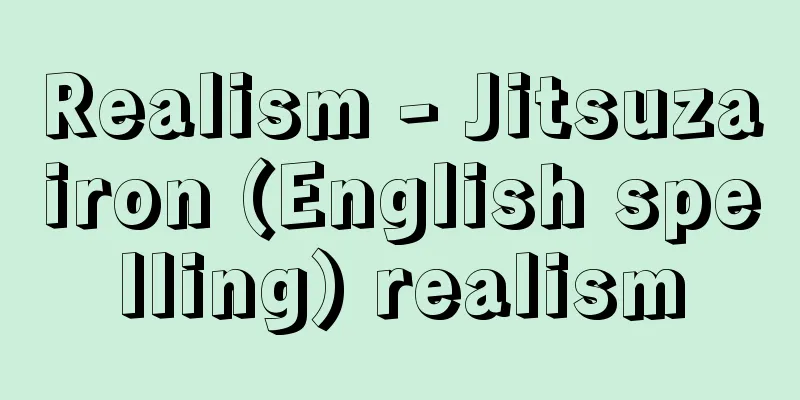Realism - Jitsuzairon (English spelling) realism

|
A translation of the word "realism" in philosophy. An epistemological approach that recognizes objective existence independent of consciousness and subjectivity, and regards it as the goal and standard of correct cognition. It is opposed to idealism, but realism in the sense of recognizing the reality of universal concepts is not necessarily opposed to idealism. In other words, the position that recognizes the reality of abstract universal concepts such as desks in general and triangles in general in contrast to individual objects such as individual desks and triangular shapes is sometimes called realism. However, it is idealist in that it recognizes transcendental, ideal objects that are different from individual objects as empirical reality. Therefore, the term "realism" is appropriate for this tendency, as a term opposed to nominalism, which does not recognize the existence of universal reality other than individual objects. Aside from the issue of universals, the following positions and problems are pointed out in realism. [1] Naive realism: A position that considers perception and experience to be real in and of themselves. This is a tendency seen in naive metaphysical materialism, but it is not uncommon for this to be questioned on the grounds of the subjectivity and relativity of the directly given, which is based on psychological "illusions." [2] Scientific Realism There is a tendency (Gassendi, Locke, and others) to consider first qualities such as physical extension, solidity, and motion as objective real properties behind subjective second qualities such as color, smell, and warmth, and this has become influential with the development of modern scientific explanations of cognition and mechanical considerations of matter. However, as empirical objects, it is clear that first qualities, like second qualities, are relative to the subject, and extension and motion are themselves the product of abstraction from experience. Moreover, scientific research constantly changes the definition of real properties. For the above reasons, this position also has problems. [3] Kant and subsequent positions Kant further considered all objects of empirical cognition, including first qualities, to be "phenomena," and assumed that behind them there exist "things in themselves" that transcend the possibility of cognition. It can be said that the various positions of realism after Kant were born around the concept of the thing-in-itself problem. Furthermore, from the 19th to the 20th century, various positions of realism and positivism arose throughout Europe as a reaction and criticism against German idealism, with Hegel at its apex. Examples of these include those of the neo-Kantian school (A. Riehl, N. Hartmann, etc.), which tried to interpret Kant more realistically, and dialectical materialism, which advocated materialism and imitation theory but abandoned the idea of naive realism and static cognition of the objective, and took the position of dynamic scientific realism. [4] Realism in modern Anglo-American philosophy In addition to the above-mentioned trends in continental Europe, especially in Germany, there is a strong contemporary realism in the UK and the US. The Cambridge Analytical School (Russell, Moore, Wittgenstein, etc.) emerged in the early 20th century as a critique of the idealism of the British Hegelian school, and together with modern American realism, it is called new realism. The latter is the viewpoint of six people, including Perry and Spaulding, who published a joint collection of essays, The New Realism (1912), who considered the pragmatist view of truth to be subjective, and accepted that objectivity in a broad sense, including abstract objects, is independent of consciousness, and believed that cognition is possible in relation to external things. The above are collectively referred to as critical realism, but this name more narrowly refers to the British philosopher Hicks and the seven American philosophers (Santayana, Lovejoy, and others) who published Essays in Critical Realism (1920) as the result of their joint research. They pointed out the fallacy of subjectivism and also criticized the extreme realism of Perry and others, and acknowledged the existence and distinction of three entities: the act of perception, the given as a complex of properties, and the object of perception. Pragmatism can be said to be a kind of empirical realism, but logical positivism influenced by the Cambridge Analytical School, as well as the tendencies of Moore of the Cambridge Analytical School and the British Ordinary Language School, which follows on from the later Wittgenstein, also contain extremely important points of empirical realism. Logical positivism considers realism and idealism, and the conflict between them, to be metaphysical pseudo-problems arising from the confusion of language usage. Later Wittgenstein also considers the certainty of the existence of external objects to be a fundamental form of life whose evidence has already run out and for which justification is unnecessary and impossible. Among the Ordinary Language School, there are those who consider it natural to take a common-sense position that recognizes the existence of empirical objects, provided that we leave aside the non-ordinary abstract generalizations made by philosophical terms, and there are those who, like Austin, consider the criticism of realism based on "illusions" to be unjustified. The significance of the above trend is as follows: (1) it is a refinement of the realism of common sense philosophy, (2) it eliminates the fundamental difficulty of the traditional trend that discusses the relationship with the fundamentally non-empirical reality behind experience, and (3) it does not materialize scientific properties and laws as in conceptual realism, but considers them as a symbol system abstracted and constructed from experience. Pragmatism in particular takes a flexible and adaptable perspective that sees this kind of opportunity as a tool or means for understanding experience. [Takahide Toshita] [References] | | | | | | | |Source: Shogakukan Encyclopedia Nipponica About Encyclopedia Nipponica Information | Legend |
|
哲学上のリアリズムrealismの訳語。認識論の考え方で、意識、主観とは独立の客観的存在を認め、それを正しい認識の目的、基準とする立場。観念論と対立するが、普遍概念の実在を認める意味での実在論はかならずしも観念論と対立しない。すなわち、個々の机や三角形の図形などの個物に対して、机一般、三角形一般などの抽象的普遍概念の実在を認める立場も実在論とよばれるときがある。しかし、それは経験的実在としての個物とは異なった、超越的、観念的対象を認める点では観念論的である。そこで、この傾向には、個物以外に普遍の実在を認めない唯名(ゆいめい)論に対立する用語としての「実念論」という名称が適切である。普遍の問題を別にして、実在論には次のような立場と問題が指摘される。 〔1〕素朴実在論 知覚、経験をそのまま実在と考える立場。素朴な形而上(けいじじょう)学的唯物論などにみられる傾向だが、心理的な「錯覚」などに基づく直接所与(しょよ)の主観性、相対性を理由に疑問視されることがまれでない。 〔2〕科学的実在論 色、匂(にお)い、寒暖などの主観的な第二性質の背後に、実在の客観的性質として物理的な延長、固体性、運動などの第一性質を考える傾向(ガッサンディ、ロックら)があり、認識の近代科学による説明と物質の機械観的な考察の進展に応じて有力となった。しかし、経験的対象としては、第一性質が第二性質と同様に主観と相対的なことも明らかであり、延長や運動それ自体は経験からの抽象の所産である。しかも、科学的探究は実在的性質の定義を不断に変化させる。以上の点で、この立場も問題をもつ。 〔3〕カントとそれ以後の立場 そこで、さらにカントは第一性質も含めた経験的認識の全対象を「現象」として、その背後に認識の可能性を超えた「物自体」を想定した。カント以後の多様な実在論の立場は、物自体という問題の概念をめぐって生まれたともいえる。さらに19世紀から20世紀にかけて、ヘーゲルを頂点とするドイツ観念論への反動、批判として、全ヨーロッパに多彩な実在論、実証主義の立場が生じた。カントをいちだんと実在論的に解釈しようとする新カント学派のある者(A・リール、N・ハルトマンら)、唯物論、模写説を主張しながらも、素朴実在論と客観の静的な認識という考えを捨てて、動的な科学的実在論の立場をとる弁証法的唯物論などがその例である。 〔4〕現代英米哲学の実在論 以上のヨーロッパ大陸、とくにドイツを中心とした流れのほかに、英米に有力な現代実在論がある。すなわち、20世紀初頭のケンブリッジ分析学派(ラッセル、ムーア、ウィットゲンシュタインら)は、イギリス・ヘーゲル学派の観念論への批判として台頭し、アメリカの現代実在論とともに新実在論とよばれる。後者は共同論集『新実在論』The New Realism(1912)を刊行したペリー、スポールディングら6人の見地で、彼らはプラグマティズムの真理観も主観的と考え、抽象的対象も含めた広義の客観が意識から独立であることを認め、それと外的関係において認識は成り立つと考えた。以上は一括して批判的実在論ともいわれるが、この名称は、狭くはイギリスのヒックスと、とくに『批判実在論論集』Essays in Critical Realism(1920)を共同研究の成果として刊行した7人のアメリカ哲学者(サンタヤーナ、ラブジョイら)をいう。彼らは主観主義の誤謬(ごびゅう)を指摘するとともに、ペリーらの極端な実在論も批判し、知覚作用、性質複合としての所与、知覚の対象の三者の区別と存在を認める。 プラグマティズムも一種の経験的実在論といえるが、さらにケンブリッジ分析学派の影響を受けた論理実証主義、また同学派のムーアと、後期ウィットゲンシュタインの流れをくむイギリス日常言語学派の傾向は、経験的実在論としてもきわめて重要な論点を宿す。論理実証主義は、実在論と観念論および両者の対立そのものが、言語の用法の混乱から生ずる形而上学的擬似問題と考える。また後期ウィットゲンシュタインは、外的対象の実在の確実性はもはやその証拠の底がつき、正当化を不要、不可能とする生(せい)の根源的形式と考える。また日常言語学派のなかには、哲学用語による非日常的な抽象的概括化を離れれば、経験的対象の実在を認める常識的立場を自然と考える者、オースティンのように「錯覚」による実在論の批判を不当とする見地もある。 前記の傾向の意義としては、以下のような点があげられる。(1)常識哲学の実在論の洗練であり、(2)経験の背後の原理的に非経験的な実在との関係を論ずる、伝統的傾向の根本的難点を排し、(3)概念実在論のように科学的諸性質や法則を実体化せずに、それらを経験から抽象され構成された記号体系と考える。とくにプラグマティズムは、この種の契機を経験理解のための道具、手段とみる柔軟で融通の効く観点をとっている。 [杖下隆英] [参照項目] | | | | | | | |出典 小学館 日本大百科全書(ニッポニカ)日本大百科全書(ニッポニカ)について 情報 | 凡例 |
Recommend
Kaizaiku (English) Winged everlasting
An annual plant of the Asteraceae family native to...
Tiberios Constantine
?‐582 Byzantine Emperor. Reigned 578-582. He ascen...
LPG Tanker - LPG Tanker
...Loading and unloading is usually completed wit...
Lake Hibarako
It is one of the lakes and marshes in the Bandai P...
Compressibility
…The higher the bulk modulus, the harder the mate...
Ryubidan - Ryubidan
A platform at the northern end of the Chodoin at H...
Foehn - Foehn (English spelling)
A warm, dry wind that occurs on the lee side of a...
Jenney, WLB (English spelling) JenneyWLB
…At the time, Chicago was developing as a commerc...
Michler's ketone
Another name for 4,4'-bis(dimethylamino)benzop...
Serval - serval (English spelling)
It is a member of the Felidae family of the Carni...
Lasiorhinus latifrons (English spelling)
…A burrowing marsupial with teeth similar to thos...
Solar (English spelling)
It is often used in the form of a compound word to...
Arezzo (English spelling)
Arezzo is the capital of the Province of Arezzo in...
Forster, JR (English spelling) ForsterJR
…He was also one of the leading natural scientist...
Cowell, Henry Dixon
Born March 11, 1897 in Menlo Park, California. [Di...









